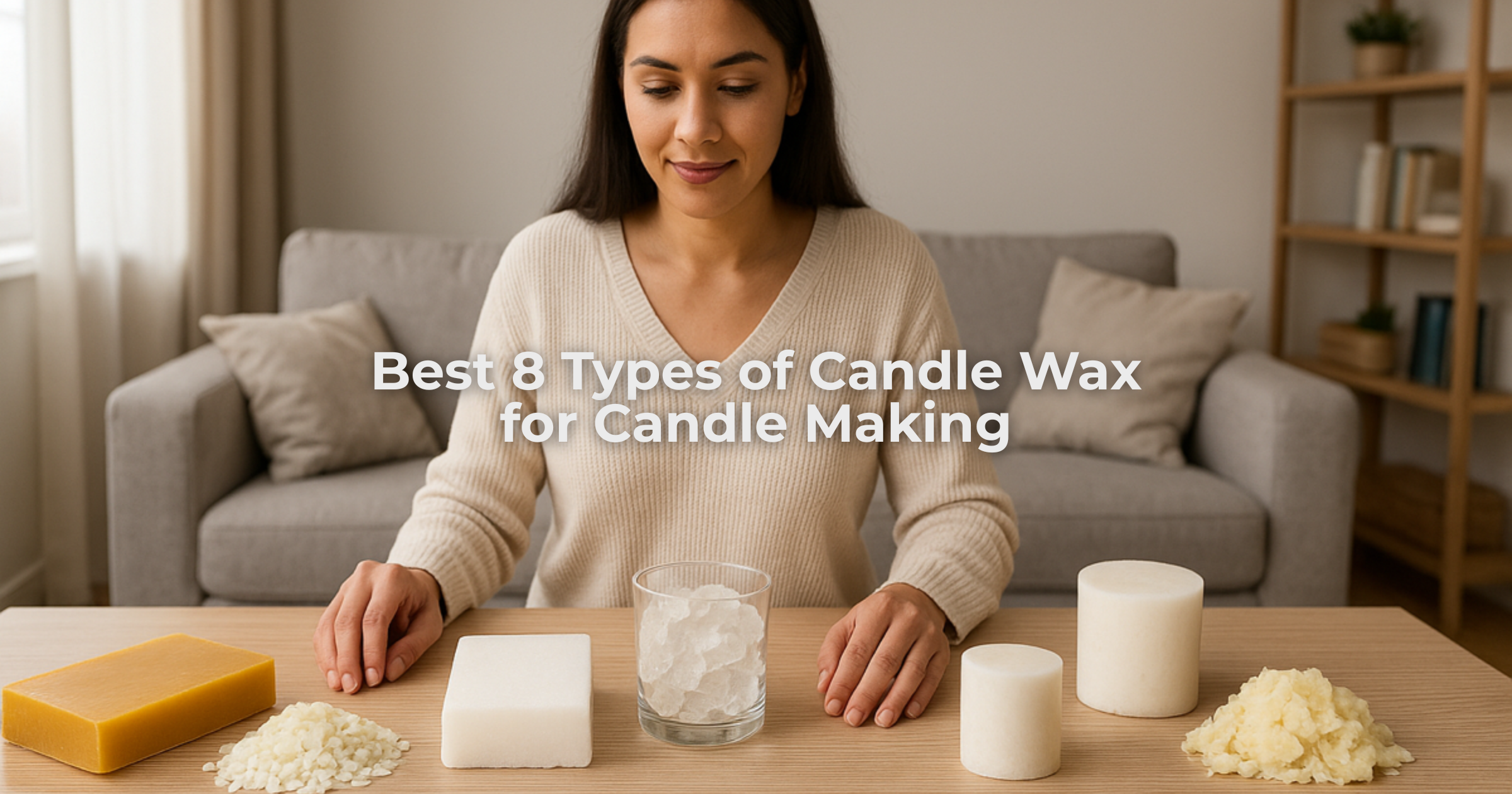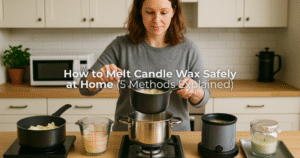Best 8 Types of Candle Wax for Candle Making

When I first began experimenting with candle making, I didn’t realize how much a candle’s performance depends on its wax.
The way a candle burns, its fragrance throw, and even the look of the flame all trace back to wax chemistry. Each candle wax variety, whether natural or synthetic, offers a different experience, from clean air to rich aroma.
Today, that knowledge matters more than ever. The global candle market was valued at USD 14.06 billion in 2024 and is projected to reach USD 20.10 billion by 2030, growing at 6.4% annually.
With demand surging, understanding different types of candle wax helps creators and buyers make informed, sustainable choices.
Let’s explore the main types of wax for candle making, their pros and cons, and where each one truly shines.
1. Beeswax
Beeswax (cera alba) is one of the oldest natural candle wax materials used by humans. It’s secreted by honeybees as they build honeycombs, then collected and purified. The result is a dense, golden wax with a subtle, natural honey aroma that feels luxurious and pure.
I’ve always admired how beeswax candles emit a warm, clean light that makes any space feel serene.
Beeswax burns longest among all waxes; tests show it can last up to five times longer than paraffin of equal size
Pros:
- 100% natural candle wax produced by honeybees with a subtle honey aroma.
- Extremely clean-burning wax that emits minimal smoke and soot.
- Long wax burn time due to high melting point and dense structure.
- Naturally purifies air by releasing negative ions while burning.
- Offers excellent color stability and retains its shape well in warm conditions.
Cons:
- Higher production cost compared to soy or coconut wax.
- Limited fragrance load capacity; doesn’t retain synthetic scents effectively.
- Slightly harder to mold due to high hardness and cooling behavior.
- Fewer color and scent customization options for commercial makers.
What Is Beeswax Used for in Candles?
Beeswax is often used in beeswax candles for religious or meditative purposes, rolled taper candles, and natural decor candles that showcase its organic beauty.
2. Soy Wax
Derived from soy (Glycine max) beans, soy wax has become a favorite among modern candle makers, including myself. It’s a biodegradable wax that’s renewable, non-toxic, and perfect for crafting eco-friendly candle wax products.
I started using soy wax for my container candles because it gives a creamy, smooth finish and burns evenly with excellent scent retention.
Controlled combustion studies confirm that soy wax burns more slowly and produces less soot than paraffin
Pros:
- Vegetable-based wax that’s renewable, biodegradable, and non-toxic.
- Produces a smooth, creamy finish ideal for container candles.
- Burns longer and cooler than paraffin wax candles, improving safety and value.
- Delivers balanced hot and cold throw performance.
- Easy to clean from surfaces and cost-effective for beginners.
Cons:
- Can experience wax frosting, affecting visual appearance.
- Softer wax with a low melting point, not suitable for tall pillars.
- May have inconsistent container adhesion without proper curing.
- Slightly muted fragrance intensity compared to paraffin-based options.
What Is Beeswax Used for in Candles?
Common in soy wax candles and melts, this wax is ideal for jars and containers. It pairs well with fragrance oils and natural wicks for DIY candle making.
3. Paraffin Wax
If you’ve ever bought candles from major retail brands, chances are they were made with paraffin. This synthetic candle wax is refined from petroleum and remains popular due to its versatility and cost-effectiveness.
In my early experiments, I found paraffin to be incredibly easy to work with, especially when I wanted vibrant colors and a strong fragrance.
Pros:
- Most versatile and affordable candle wax, ideal for large-scale production.
- Excellent scent retention and color stability for vibrant, scented candles.
- Predictable cooling behavior minimizes cracks or air pockets.
- High fragrance load capacity ensures powerful scent throw.
- Easily customizable with candle dyes, molds, and fragrance oils.
Cons:
- Petroleum-based wax, not environmentally sustainable.
- Produces some smoke and soot if improperly wicked.
- May cause indoor residue buildup over long-term use.
- Perceived as less “natural” compared to plant-based alternatives.
What Is Paraffin Wax Used for in Candles?
Used widely in paraffin wax candles for decorative, container, and pillar applications. Many candle brands and manufacturers like IGI Wax and Golden Brands Wax offer blends that balance paraffin’s performance with natural waxes.
4. Gel Wax
Unlike solid waxes, gel wax is made from mineral oil and polymer resin, resulting in a transparent, jelly-like texture.
When I first experimented with it, the clarity fascinated me. You can embed shells, glitter, or dried flowers, creating candles that look like glass art.
Pros:
- Unique transparent synthetic candle wax is perfect for artistic designs.
- Very long burn time due to dense gel composition.
- Ideal for decorative candles with embedded elements (flowers, shells, glitter).
- Stable structure that holds shape well in containers.
- Allows creative freedom with layered color effects.
Cons:
- Not a true wax; made from mineral oil and polymer resin.
- Limited fragrance load; some oils may cause cloudiness.
- Requires precise temperature control during pouring.
- Not biodegradable or suitable for eco-conscious brands.
What Is Gel Wax Used for in Candles?
Common in decorative candles that showcase embedded objects or layered designs. Perfect for creative projects rather than everyday burning.
5. Palm Wax
When I first used palm wax, I was amazed by the natural crystalline pattern it forms as it cools. It’s derived from palm oil, a renewable resource, and when sourced responsibly, it can be part of a sustainable wax option.
The texture and finish of palm wax candles give them a feathered, marble-like appearance that looks elegant even without color or scent.
Pros:
- Natural candle wax derived from palm oil, renewable and firm.
- Creates stunning crystalline patterns and feathered textures upon cooling.
- High melting point provides durability in warmer climates.
- Strong fragrance load capacity with vivid color payoff.
- Burns cleanly with minimal smoke when properly wicked.
Cons:
- Sourcing may raise sustainability concerns if not RSPO-certified.
- Hard texture makes it unsuitable for soft container candles.
- A higher shrinkage rate during cooling can cause surface cracks.
- Limited availability of verified eco-friendly palm oil suppliers.
What Is Palm Wax Used for in Candles?
Ideal for decorative pillars, sculpted candles, and votives. Many professional makers use palm wax blends to achieve artistic crystalline patterns and longer burn stability.
6. Coconut Wax
Among newer candle waxes, coconut wax has gained popularity for its luxurious feel and eco-friendly nature. Made from coconut oil, it’s one of the most biodegradable wax choices available.
When I first poured coconut wax candles, I noticed the creamy texture and how effortlessly it blended with fragrance oils — a dream for any artisan candle maker.
Pros:
- Biodegradable wax made from cold-pressed coconut oil.
- Smooth, creamy texture ideal for luxury candle lines.
- Superior scent throw both hot and cold due to low viscosity.
- Clean-burning with minimal soot and excellent surface finish.
- Perfect base for blended wax candles with soy or apricot wax.
Cons:
- Premium material, often higher in cost than soy or paraffin.
- Soft consistency can affect structural firmness in hotter climates.
- Limited stand-alone availability; often sold as hybrid wax blends.
- Requires careful wicking to maintain an even wax melt pool.
What Is Coconut Wax Used for in Candles?
Used in coconut wax candles, luxury jar candles, and blends with soy or apricot wax for high-end scented collections. Popular among eco-conscious brands for its sustainability and aesthetics.
7. Rapeseed Wax
Also known as canola wax, rapeseed wax is becoming a preferred choice in Europe for those seeking a vegetable-based wax that’s locally sourced. It’s made from the oil of the rapeseed plant, providing a natural and sustainable option similar to soy but with unique benefits.
My experience with rapeseed wax showed how beautifully it sets in glass containers, leaving a smooth, creamy top.
Pros:
- Vegetable-based wax sourced sustainably from rapeseed (canola) crops.
- Excellent container adhesion, minimizing sinkholes or air gaps.
- High opacity level and silky finish for an upscale aesthetic.
- Long burn time with steady, low-smoke performance.
- Great for vegan candles and small-batch artisans.
Cons:
- Limited global availability; higher import costs outside Europe.
- It can exhibit minor frosting in cooler environments.
- Softer structure compared to palm or paraffin wax.
- Less tested commercially, so fewer standardized melting point references.
What Is Rapeseed Wax Used for in Candles?
Perfect for container candles and vegan formulations. It’s often used by sustainable brands that focus on low-carbon, locally sourced materials.
8. Blended Wax
In my workshop, I often experiment with blended wax candles to achieve the best balance between fragrance throw, burn quality, and cost. Blended wax refers to combining two or more waxes, such as soy-paraffin, soy-coconut, or beeswax-palm, to optimize performance.
This flexibility allows both small artisans and large manufacturers to customize wax blend compositions based on specific needs.
Pros:
- Custom wax blend compositions combine the best traits of multiple waxes.
- Enhanced hot throw, scent retention, and color stability.
- Reduced production cost while maintaining performance balance.
- Consistent cooling behavior and fewer surface flaws.
- Adaptable to different candle types — containers, pillars, and melts.
Cons:
- Sustainability depends on ingredients (e.g., paraffin-soy vs soy-coconut blend).
- Can confuse buyers who prefer “100% natural” labeling.
- Blends vary widely by brand; performance consistency may differ.
- Some combinations alter melting points, requiring new pour techniques.
What Is Blended Wax Used for in Candles?
Common in commercial candles sold by major brands like EcoSoya, NatureWax, and CandleScience suppliers. These blends balance scent throw, smoothness, and visual appeal for large-scale production.
Final Thoughts
Choosing a wax isn’t just about cost or appearance—it’s about purpose. If you prioritize clean air and sustainability, soy, beeswax, or coconut wax candles are ideal.
For artistic freedom or affordability, paraffin or blended wax options still hold value.
Interestingly, emissions research confirms that well-formulated candles of all wax types can burn safely indoors when properly wicked and ventilated.
What truly determines air quality is the combination of fragrance oils, wicks, and additives—not just the wax itself.
As the market continues to expand beyond USD 20 billion by 2030, demand for sustainable wax options will only grow.
For those who appreciate handcrafted quality, explore Karigar Style’s candle collection, each piece crafted with eco-friendly candle wax, balanced scent profiles, and artistic precision born from real-world candle-making experience.
-
Nav Preet is the founder and creative soul behind Karigar Candles. Inspired by heritage, nature, and the warmth of handmade artistry, she crafts candles that do more than glow—they evoke emotion. Through this blog, she shares her love for scents, styling, and mindful living, one flame at a time.
Creative Head at Karigar Style







